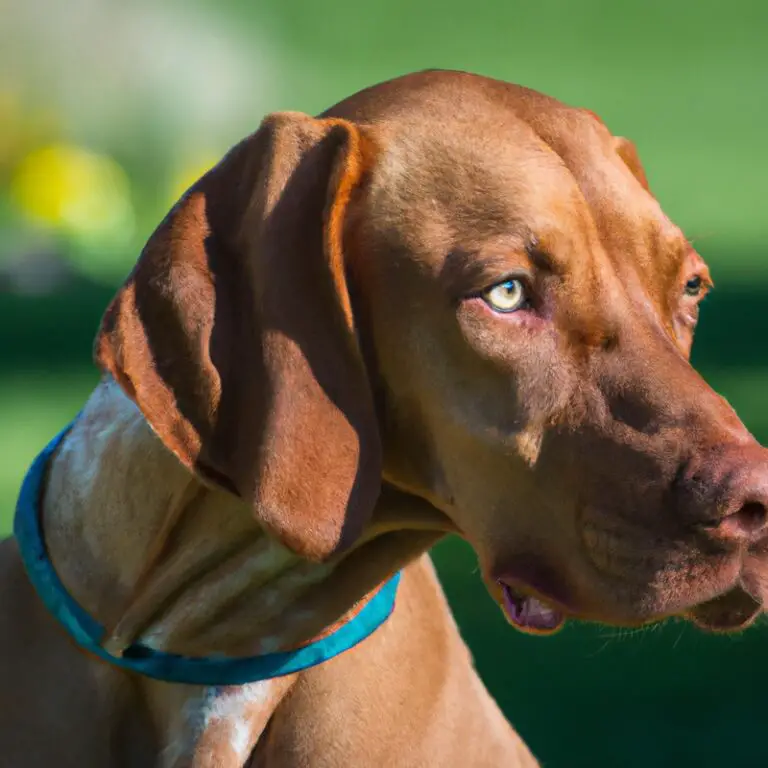How Do Vizslas Interact With Children And Other Pets?
Key Takeaways:
- Vizslas generally have a friendly and gentle attitude towards children, making them a good choice for families with kids.
- Vizslas can get along well with other pets, especially if properly socialized from a young age.
- Supervision and training are key when introducing Vizslas to children and other pets to ensure positive interactions.
- Vizslas have a playful and energetic temperament, which can make them great companions for active families.
Are you considering bringing a Vizsla into your home, but concerned about how they will interact with children and other pets?
Well, you’re in the right place! As an expert on the subject, I can provide valuable insights into the unique relationship between Vizslas, children, and other animals.
In this article, we will dive into the characteristics, temperament, and energy levels of Vizslas to understand how they naturally interact with kids and pets.
We’ll also explore tips for introducing them and ensuring a harmonious coexistence.
So, sit back, relax, and let’s embark on this exciting journey together!
| Interaction with Children | Interaction with Other Pets |
| Vizslas are known to be excellent with children. They are gentle, patient, and love to play. They are also protective and can form strong bonds with kids. However, it’s crucial to supervise interactions to avoid any accidental injuries. | Vizslas can generally get along well with other pets, including dogs and cats, if properly introduced and socialized from a young age. However, some Vizslas may have a high prey drive and may not be suitable for households with small animals such as rodents, birds, or rabbits. |
Understanding the Vizsla Breed
Overview of Vizslas’ Characteristics
Vizslas are a unique breed known for their friendly and affectionate nature.
They are highly energetic and require plenty of exercise and mental stimulation.
Vizslas are also incredibly intelligent and easy to train.
They are loyal and devoted to their families, making them great companions.
This breed is generally good with children and other pets, but early socialization and proper training are key.
Vizslas have a strong need for human interaction and can become anxious or destructive if left alone for long periods.
Overall, Vizslas are a wonderful choice for active families who can provide them with the attention and exercise they need.

Vizslas’ Temperament and Personality Traits
Vizslas have a friendly, affectionate, and energetic temperament. They are known for being loyal and highly trainable.
These dogs thrive on human companionship and enjoy being part of a family.
Vizslas are generally good with children and other pets if properly socialized from an early age. They have an innate curiosity and love to explore, which can make them active and playful companions.
It’s important to provide them with plenty of mental and physical stimulation to prevent boredom and potential behavioral issues.

Vizslas’ Energy Levels and Exercise Needs
Vizslas are highly energetic dogs that require a lot of exercise to stay happy and healthy.
They have a high activity level and need plenty of physical and mental stimulation.
Daily walks and play sessions are essential for them.
Engaging in activities like running, hiking, or swimming is ideal as it helps them burn off their excess energy.
Interactive toys and puzzle games also keep their minds active.
Remember, regular exercise is key to meeting the energy needs of your Vizsla.
Interactions Between Vizslas and Children
Vizslas’ Natural Affection towards Children
Vizslas are known for their natural affection towards children. They often become the best of friends and form strong bonds.
Vizslas are gentle, patient, and playful, which makes them a great fit for families with kids.
They love to join in on games, cuddle, and offer companionship to children. It’s important to supervise interactions between Vizslas and children to ensure safety and teach kids to be gentle and respectful towards the dog.
Supervision and Training for Vizslas and Children
Supervision and training are essential for ensuring a positive relationship between Vizslas and children. Always supervise interactions to prevent any potential problems.
Teach children how to properly approach and interact with dogs, emphasizing gentle and respectful behavior.
Training Vizslas in basic commands and obedience will help them understand boundaries and behave appropriately around children. Positive reinforcement techniques are effective for teaching both children and dogs.
Patience, consistency, and love are key in fostering a harmonious bond between Vizslas and children.
Introducing Vizslas to Children
Introducing Vizslas to children can be a positive experience.
It’s important to supervise interactions and teach both the child and the dog how to behave appropriately.
Start with short, supervised meetings and gradually increase the duration.
Encourage gentle petting and teach the child not to pull on the dog’s ears or tail.
Vizslas are generally friendly and patient with children, but it’s always important to monitor their interactions to ensure everyone’s safety.
Interactions Between Vizslas and Other Pets
Vizslas’ Compatibility with Other Dogs
Vizslas generally get along well with other dogs when properly socialized from a young age.
They are known for being friendly and sociable, and can easily form strong bonds with other canines.
However, it’s important to introduce them carefully and gradually to ensure a positive interaction.
Supervision is crucial, especially when introducing them to unfamiliar dogs.
Vizslas have a playful nature and enjoy having canine companions to keep them company.
With patience and proper introductions, Vizslas can have harmonious relationships with other dogs.
Introducing Vizslas to Other Dogs
Introducing Vizslas to other dogs can be a positive experience with the right approach. Start by choosing a neutral location for the introduction, like a park.
Allow the dogs to approach each other slowly and sniff each other’s scent.
Keep the initial meeting short and supervised to prevent any potential conflicts. Gradually increase the duration of their interactions as they become more comfortable.
Remember to provide each dog with plenty of positive reinforcement and rewards for friendly behavior.
Patience and positive experiences are key when introducing Vizslas to other dogs.
Vizslas and Cats
Vizslas and cats can have a good relationship with proper introduction and supervision. It’s important to consider the individual personalities of both the Vizsla and the cat.
Slowly introduce them in a controlled environment and observe their interactions.
Allow them to get familiar with each other’s scents before any direct contact. Set clear boundaries and provide separate spaces for each pet.
With patience and positive reinforcement, Vizslas and cats can learn to coexist peacefully.
Tips for a Harmonious Coexistence
Socializing Vizslas from a Young Age
Socializing Vizslas from a young age is essential for their well-being.
Expose them to different environments, people, and other animals to build their confidence and social skills.
Take them on walks, to parks, and introduce them to new experiences gradually.
Encourage positive interactions with children and other pets to foster a harmonious coexistence.
Consistency, patience, and positive reinforcement are key to successful socialization.
Always ensure their safety and provide a controlled and positive environment for learning.
Providing Proper Training and Boundaries
Proper training and setting boundaries are essential for fostering a harmonious coexistence with your Vizsla and other pets or children.
Start by establishing consistent rules and routines, such as designated spaces for your dog and teaching them basic obedience commands.
Use positive reinforcement techniques like rewards and praise to encourage desired behavior, and be patient and consistent in your approach.
Supervise interactions with other pets and children, providing guidance and redirecting any inappropriate behavior.
Remember, clear boundaries and consistent training will help create a happy and well-behaved companion.
Ensuring Sufficient Exercise and Mental Stimulation
To ensure that your Vizsla is getting enough exercise and mental stimulation, there are a few key things you can do. Firstly, it’s important to provide regular opportunities for physical activity, such as daily walks, runs, or playtime in a fenced yard.
Additionally, engaging in interactive games and training sessions can help to stimulate their mind.
Secondly, consider incorporating puzzle toys or treat dispensers to keep your Vizsla mentally stimulated when you’re not able to actively engage with them. Providing them with stimulating toys to chew on can also help satisfy their natural instinct to explore and problem-solve.
Frequently Asked Questions (FAQs)
Are Vizslas safe to have around small children?
Vizslas can be safe and great companions for small children. Their energetic and playful nature makes them excellent playmates, and they are known for their gentle and affectionate temperament.
However, it’s important to remember that every dog is an individual, and proper training and socialization are key.
Supervision is also crucial to ensure the safety of both the child and the dog. Teaching children how to interact respectfully and gently with the dog is essential.
Can Vizslas get along with other pets, such as cats?
Vizslas can generally get along well with other pets, including cats.
As social and friendly dogs, Vizslas have a tendency to form positive relationships with other animals in the household.
However, every dog is unique and it’s important to introduce them properly.
Take time to supervise their initial interactions and create a safe and harmonious environment.
With patience, training, and gradual introductions, Vizslas can coexist peacefully with cats and other pets.
How can I introduce my Vizsla to a new pet?
Introducing your Vizsla to a new pet can be a smooth process with some thoughtful steps.
Start by bringing them together in a neutral space and supervising their initial interactions.
Allow them to sniff and observe each other without interference.
Gradually increase their time together and provide positive reinforcement for calm behavior.
Keep an eye on their body language and intervene if any signs of aggression or discomfort arise.
Remember, patience and gradual introductions are key to a successful integration.
What should I do if my Vizsla shows aggression towards children or other pets?
If your Vizsla shows aggression towards children or other pets, it’s important to address the issue promptly and seek professional help if needed.
Here are some steps you can take:
- Assess the situation: Determine the triggers or circumstances that lead to aggression and try to understand why your Vizsla may be acting this way.
- Consult a professional: Reach out to a qualified dog trainer or behaviorist who specializes in aggression. They can assess the situation, provide guidance, and create a training plan tailored to your Vizsla’s needs.
- Supervise interactions: Until the aggression is resolved, carefully monitor your Vizsla’s interactions with children and other pets. Use management strategies such as separating them, using baby gates, or keeping them on a leash during introductions.
- Positive reinforcement training: Work with a professional to implement positive reinforcement training techniques. This will help your Vizsla learn new, appropriate behaviors and build a positive association with children and other pets.
- Consistency and patience: Changing behavior takes time, so be patient and consistent with the training methods recommended by the professional. Stay committed to working through the issue and providing a safe environment for everyone involved.
Remember, aggression should never be ignored or taken lightly.
Seeking professional help will ensure the safety of your family, your Vizsla, and other pets.
Final Verdict
Vizslas are loving and gentle companions who generally interact well with children and other pets. Their natural affection towards children makes them great family dogs, but supervision and training are essential to ensure everyone’s safety.
When introducing Vizslas to other pets, gradual introductions and positive reinforcement are key.
It’s also important to socialize Vizslas from a young age and provide them with proper training, exercise, and mental stimulation. By following these tips, you can foster harmonious coexistence between Vizslas, children, and other pets.
Remember, every dog is unique, so it’s important to monitor their behavior closely and seek professional help if needed.







